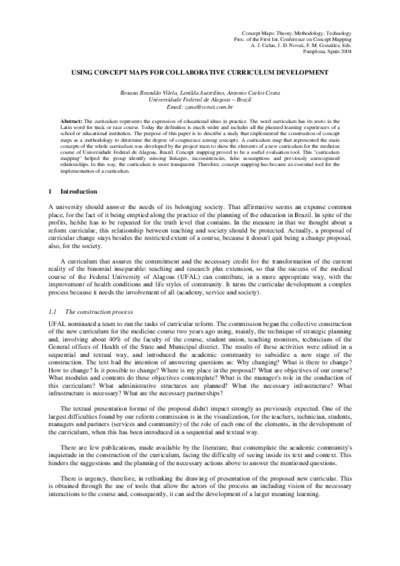Using Concept Maps for Collaborative Curriculum Development Lenilda Austrilino, Antonio Carlos Costa, Rosana Brandão Vilela Lenilda Austrilino, Antonio Carlos Costa, Rosana Brandão Vilela |
 |
 Diese Seite wurde seit 20 Jahren inhaltlich nicht mehr aktualisiert.
Unter Umständen ist sie nicht mehr aktuell.
Diese Seite wurde seit 20 Jahren inhaltlich nicht mehr aktualisiert.
Unter Umständen ist sie nicht mehr aktuell.
 Zusammenfassungen
Zusammenfassungen
The curriculum represents the expression of educational ideas in practice. The word curriculum has its roots in the
Latin word for track or race course. Today the definition is much wider and includes all the planned learning experiences of a
school or educational institution. The purpose of this paper is to describe a study that implemented the construction of concept
maps as a methodology to determine the degree of congruence among concepts. A curriculum map that represented the main
concepts of the whole curriculum was developed by the project team to show the elements of a new curriculum for the medicine
course of Universidade Federal de Alagoas, Brazil. Concept mapping proved to be a useful evaluation tool. This "curriculum
mapping" helped the group identify missing linkages, inconsistencies, false assumptions and previously unrecognized
relationships. In this way, the curriculum is more transparent. Therefore, concept mapping has became an essential tool for the
implementation of a curriculum.
Von Lenilda Austrilino, Antonio Carlos Costa, Rosana Brandão Vilela  im Konferenz-Band Concept Maps: Theory, methodology, technology (2005) im Text Using Concept Maps for Collaborative Curriculum Development
im Konferenz-Band Concept Maps: Theory, methodology, technology (2005) im Text Using Concept Maps for Collaborative Curriculum Development  Dieses Konferenz-Paper erwähnt ...
Dieses Konferenz-Paper erwähnt ...
 Dieses Konferenz-Paper erwähnt vermutlich nicht ...
Dieses Konferenz-Paper erwähnt vermutlich nicht ... 
 Nicht erwähnte Begriffe | Concept Mapping Software, Lehrplan 21 |
 Volltext dieses Dokuments
Volltext dieses Dokuments
 |  Using Concept Mapgs for Collaborative Curriculum Development: Artikel als Volltext ( Using Concept Mapgs for Collaborative Curriculum Development: Artikel als Volltext ( : :  , 26 kByte; , 26 kByte;  : :  2021-03-21) 2021-03-21) |
 Anderswo suchen
Anderswo suchen 
 Beat und dieses Konferenz-Paper
Beat und dieses Konferenz-Paper
Beat war Co-Leiter des ICT-Kompetenzzentrums TOP während er Dieses Konferenz-Paper ins Biblionetz aufgenommen hat. Er hat Dieses Konferenz-Paper einmalig erfasst und bisher nicht mehr bearbeitet. Beat besitzt kein physisches, aber ein digitales Exemplar. Eine digitale Version ist auf dem Internet verfügbar (s.o.). Aufgrund der wenigen Einträge im Biblionetz scheint er es nicht wirklich gelesen zu haben. Es gibt bisher auch nur wenige Objekte im Biblionetz, die dieses Werk zitieren.










 Biblionetz-History
Biblionetz-History